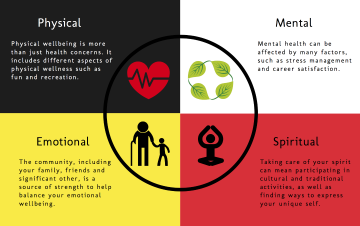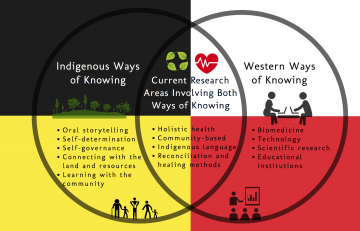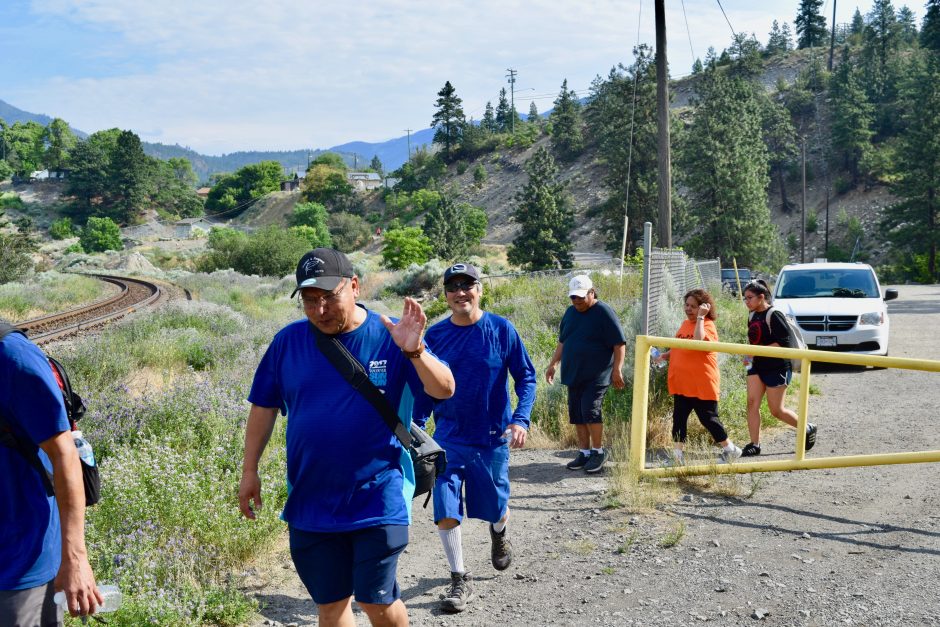We are proud of our Indigenous led and community-based initiatives. As illustrated in the following Infographic, we recognize that the health and wellness of a community is governed by circular relationships in wholistic wellness. We recognize these important relationships in each of our community-based initiatives.

Source: Infographic created by trainee Henry Lai under the guidance of Dr. Rosalin Miles.
Two-Eyed Seeing Approach
Our Indigenous Studies in Kinesiology program was co-created using principles of the “Two-Eyed Seeing” approach (Iwama et al., 2009) involving a respectful sharing space to integrate traditional and scientific ways of knowing. This is based on the understanding that community-based interventions that employ the “Two-Eyed Seeing approach” (combining traditional and Western perspectives) are effective strategies to improve health and wholistic wellness among Indigenous communities (Foulds et al., 2011; Hall et al., 2016; Iwama et al., 2009; Lai et al., 2019; Marshall & Bartlett, 2009; Paraschak & Tirone, 2008; Rowan et al., 2015).

Source: Infographic created by trainee Henry Lai under the guidance of Dr. Rosalin Miles.
In our community-based work, we take a participatory action research approach involving the community in all aspects of the research, from start to finish. This approach adheres to the First Nations Principles of Ownership, Control, Access, and Possession of research data as defined by OCAP® (2019).
Key References
Blodgett, A. T., Schinke, R. J., Peltier, D., Fisher, L. A., Watson, J., & Wabano, M. J. (2011). May the circle be unbroken: The research recommendations of Aboriginal community members engaged in participatory action research with university academics. Journal of Sport and Social Issues, 35(3), 264-283. doi:10.1177/0193723511416984
Foulds, H. J., Bredin, S. S. D., & Warburton, D. E. R. (2011). The effectiveness of community based physical activity interventions with Aboriginal peoples. Preventive Medicine, 53(6), 411-416. doi: 10.1016/j.ypmed.2011.09.008
Iwama, M., Marshall, M., Marshall, A., & Bartlett, C. (2009). Two-eyed seeing and the language of healing in community-based research. Canadian Journal of Native Education, 32(2), 3-23.
Hall, L., Dell, C. A., Fornssler, B., Hopkins, C., Mushquash, C. & Rowan, M. (2016). Research as cultural renewal: Applying two-eyed seeing in a research project about cultural interventions in First Nations addictions treatment. International indigenous Policy Journal, 6(2). doi:10.18584/iipj.2015.6.2.4
Lai, H., Miles, R., Bredin, S., Kaufman, K., Chua, C., Hare, J., Norman, M., Rhodes R. E., Oh, P., & Warburton, D. E. R. et al. (2019). “With Every Step, We Grow Stronger”: The Cardiometabolic Benefits of an Indigenous-Led and Community-Based Healthy Lifestyle Intervention. Journal of Clinical Medicine, 8(4), 422. MDPI AG. Retrieved from http://dx.doi.org/10.3390/jcm8040422
Marshall, A., & Bartlett, C. (2009). Co-learning re:“Talking and walking together” of Indigenous and mainstream sciences. [Powerpoint slides]. Retrieved from http://integrativescience.ca/uploads/articles/2009February-Bartlett-Marshall-Integrative-Science-Two-Eyed-Seeing-Aboriginal-CEPI-Indigenous-knowledge-environmental-planning.pdf
Paraschak, V., & Tirone, S. (2008). Race and ethnicity in Canadian sport. In J. Crossman (Ed.), Canadian sport sociology (pp. 79-88). Scarborough, ON: Nelson Thompson Learning.
Rowan, M., Poole, N., Shea, B., Mykota, D., Farag, M., Hopkins, C., Hall, L., Mushquash, C., Fornssler, B., & Dell, C. A. (2015). A scoping study of cultural interventions to treat addictions in Indigenous populations: Methods, strategies and insights from a two-eyed seeing approach. Substance Abuse Treatment, Prevention and Policy, 10. doi: 10.1186/s13011-015-0021-6
